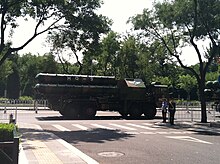HQ-9
'Red Banner-9') is a long-range semi-active radar homing (SARH) surface-to-air missile (SAM) developed by the People's Republic of China.
[3][4][7] Justin Bronk of the Royal United Services Institute describes the missile as a "hybrid design based on the Russian SA-20 but with radar, seeker head and C2 elements heavily influenced by American and Israeli technology.
[22] Later in the month, Turkish officials revealed that negotiations were ongoing with multiple bidders; the Chinese bid had not yet satisfied requirements concerning technology transfer.
[23] In March 2015, a China Daily article reported that it was "well-known that the Chinese FD-2000 system, a HQ-9 model for export, was chosen for the contract with Turkey in 2013" based on comments made by a CPMIEC representative at the 2015 Langkawi International Maritime and Aerospace Exhibition; the article was misleadingly called "Missile sale to Turkey confirmed.
Missiles were deployed in July 2015 to Hotan in Xinjiang, close to Kashmir across the Line of Actual Control,[26] and in February 2016 to Woody Island in the disputed South China Sea.


